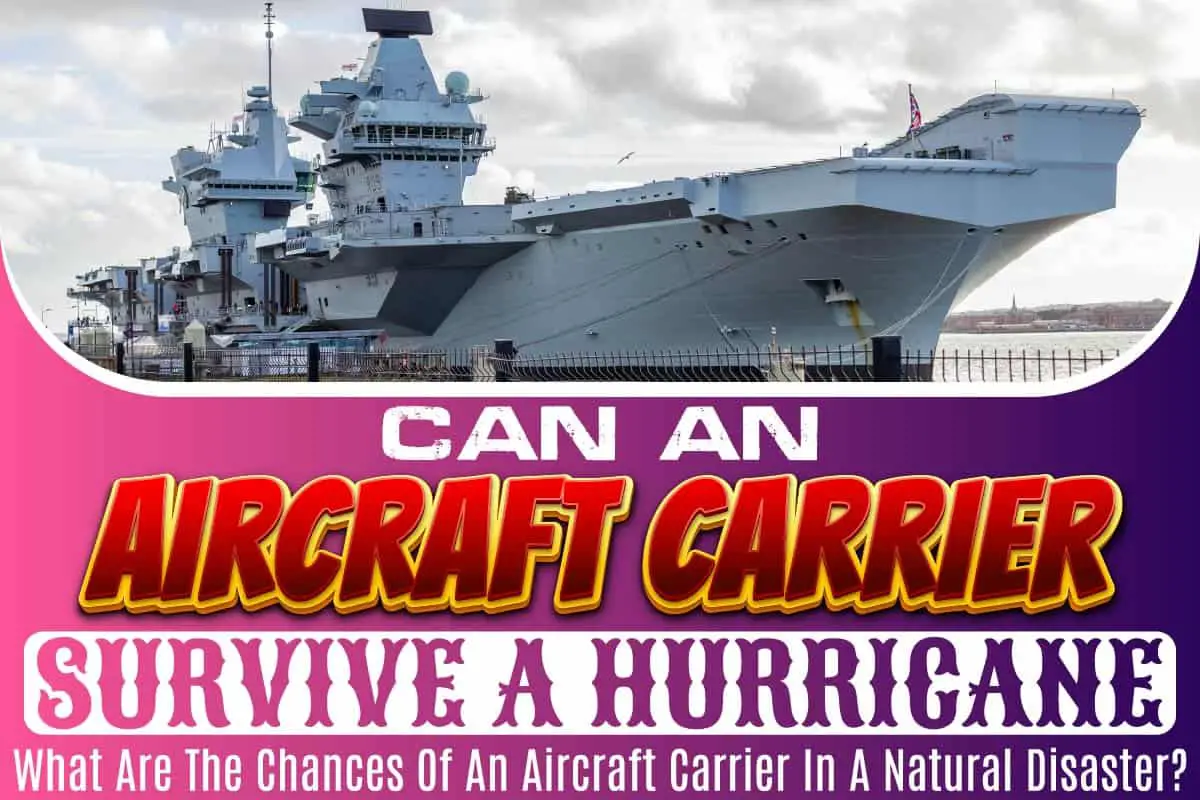An aircraft carrier is a warship that serves as a sea-bound air-base platform for fighter aircraft, is fully equipped to survive several attacks, including natural disasters. The aircraft carrier’s ability to survive certain natural disasters has been questioned. The carrier comes with several pieces of equipment, including a full-length deck and other facilities for arming, carrying, deploying, and landing war aircraft of different sizes and capabilities. Very few countries have the financial means to develop and manage aircraft carriers; most are manufactured by developed countries of the Western world and Asia.
So, Can an Aircraft Carrier Survive a Hurricane?
No. Though aircraft carriers are built to withstand the worst possible problems at sea, a hurricane will cause severe damage that disrupts its functioning.
What Are The General Features Of An Aircraft Carrier?
The following are some of the essential features you will find in any Aircraft Carriers;
1. Speed is Always a Great Asset
Speed is Different Across Different Aircraft Carriers because they need to be sent anywhere in the world quickly. They must evade any form of detection and target by the opposing force they are being used against.
Aircraft carriers must possess a minimum speed to evade any detection or attack from the enemies. To avoid attacks from war machines like nuclear submarines, aircraft carriers must maintain a speed of at least 30 knots.
2. The Larger, the Better
Aircraft carriers need to have more deck rooms because these carriers are some of the most potent weapons in the world. The larger they are, the more aircraft and other weapons they can carry.
3. They Perform Diverse Missions
Any aircraft carrier must be capable of performing diverse missions under different conditions. They possess the capability to respond quickly to crises and maintain diplomacy and power projection. They must be able to launch quick attacks from the sea where they are typically deployed. They provide the sea base for all kinds of weapons, including helicopters, Anti-surface warfare, Defensive Air counter, and many more.
4. They are not Built Just for War
One common misconception about aircraft carriers is that they were built only for launching attacks. Aircraft carriers perform much more, and they can be used in sending Humanitarian Aid, Disaster Relief, and other diplomatic purposes.
5. Aircraft Carriers Maintain Connection Within Combat Group
An ideal aircraft carrier must be capable of working within a combat group. This means the carrier should be capable of fixed-wing jets, helicopters, and smaller warships. They must support the short take-off and vertical landing for jets, among many other things.
What Are The Basic Types Of Aircraft Carriers?
There are different types of aircraft carriers, these include; regular aircraft cruisers, amphibious assault ships, and sub-ships, Anti-submarine warfare, Balloon carriers and tenders, Escort carriers, Fleet carriers, Flight deck cruisers, a Helicopter carrier, Light aircraft carriers, Sea control ships, Sea-plane tenders, and carriers.
types Of Aircraft Carriers By Categories
There are different types of aircraft carriers categorized in different ways, these are;
1. Aircraft Carrier Types by Roles
Aircraft carriers can be classified based on the roles they perform. A fleet carrier, for instance, is designed to operate as the main fleet, and because they are the largest carriers capable at the fastest speed, they are the most popular for combats.
The Escort carriers are aircraft carrier types are designed solely to provide defense for some convoys of ships. These are usually smaller and slower than Fleet carriers. Merchant aircraft carriers are built for cargo, and they deliver mostly items like smaller weapons and humanitarian aids.
Light aircraft carriers can also operate like fleet carriers, but they are smaller and operate at slower speeds.
2. Configuration-based Types
Aircraft carriers are also classified based on their configuration. The Catapult-assisted carriers are designed to carry the most significant and heaviest military aircraft, but the weight capacity of some is limited. Many of these types of aircraft carriers are nuclear-powered.
The short take-off barrier-arrested types of carriers are designed to carry limited light fixed-wing aircraft. They are often designed to maintain air superiority over the enemy plus fleet dense role rather than actual combat.
The short take-off and vertical landing carrier, also known as STOVL, is designed to carry only STOVL aircraft. Limited payloads and limited performance characterize them. The amphibious assault ship, for instance, is categorized under the STOVL carrier type.
The Helicopter carrier is another aircraft carrier with a very similar appearance to other carrier types but is limited to operating helicopters and some fixed-wing aircraft. Helicopter carriers are driven mainly by the Navy, and there are roughly sixteen of these helicopter carriers. Helicopters on this carrier are often tasked with landing and supporting ground forces, especially within the enemy territory.
3. Classification by Size
By Size, aircraft carriers are classified into three: Fleet carriers, Light aircraft carriers, and Escort carriers.
The Description Of An Aircraft Carrier
The Aircraft carrier comes with a structure of diverse components, and these include the following;
1. The Structure
Aircraft carriers are designed as long and large ships, but there could be a variation of the designs depending on the carriers’ intention.
Regardless of the Size of the carrier, a carrier must house the number of aircraft they are designed for. There must be enough space for launching, storing, and maintaining aircraft, helicopters, and other components. There should also be enough space for enough crew comprising food, personnel, and enough space for propulsion.
The top of the aircraft carrier is the flight deck, where aircraft are launched and recovered. The Island is located at the starboard, where the air traffic control, funnel, and bridge components are located.
2. Constraint of Construction
Due to the constraints of the construction of the flight deck, the effectiveness and capacity of an aircraft carrier can be limited. The sizes of the aircraft carrier will influence the weight, type, and configuration of the aircraft that is launched. You can only find the assistant launching feature on larger carriers.
Due to the busy feature of the flight deck, less than 20 aircraft are usually allowed on a carrier at a time, in most cases. There is also hanger storage below the flight deck where most aircraft are stored when not in operation. With an elevator, an aircraft is taken from the lower deck to the flight deck for operations.
Just like aircraft that are not in use, ammunition is also stored in the lower decks. Highly explosive materials are stored below water levels below the flight deck so that the carrier wouldn’t become flooded if an explosion occurs.
3. The Flight Deck
This constructed region on the carrier is the runway of the aircraft carrier. These flat-top launches and recover all aircraft. There are constraints on the flight deck; the fact that it is located on the sea means full-length runaway will be practically impossible and will be very costly to make.
A shorter runway on the flight deck means an aircraft will have to accelerate faster before take-off. Sometimes a reduced take-off load will be required to allow the aircraft to gain enough momentum on the runway before flying.
There are different types of flight deck configurations. One philosophy is that more thrust must be added to the aircraft, for instance, the use of a Catapult-assisted take-off. Another philosophy is to change the direction of the airplane trust. Both philosophies come with their advantages and disadvantages.
The catapult-assisted take-off configuration involves using an electric or steam catapult to accelerate an aircraft through a safe-flying speed. Further propulsion of the aircraft when its engines will provide airborne. This strategy will allow the most heavily-loaded aircraft to take off efficiently.
The short take-off But Arrested Recovery is a strategy where the net lift of the aircraft is increased. In this case, the aircraft will not require any catapult-assisted take-off, but an upward vector is provided at the end of the flight deck to reduce load.
The short take-off vertical landing and the vertical take-off and landing are the other two strategies used in assisting aircraft in taking off successfully on the flight deck.
Conclusion
The issue of whether an aircraft carrier will survive in a hurricane will largely depend on the severity of such a disaster. With a lower magnitude hurricane, the carrier may suffer minor to severe damages, and there is a possibility of spending lower costs on repairs. With a medium to highly severe hurricane, the possibilities of recovering an aircraft carrier is very little. In most cases of severe hurricanes , the entire aircraft carrier will be replaced , and damaged parts will have to be re-constructed to reduce risks of fatalities on components and lives. There are always ongoing researches on aircraft carrier construction, especially in ways of minimizing damages in the face of natural disasters like the hurricanes.
You May Like These Articles As Well:
 Being Human
Being Human





